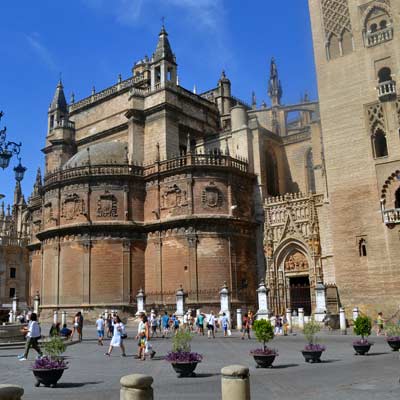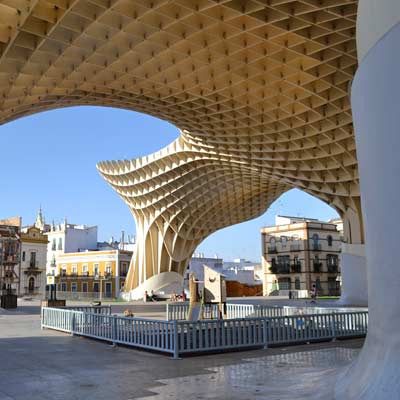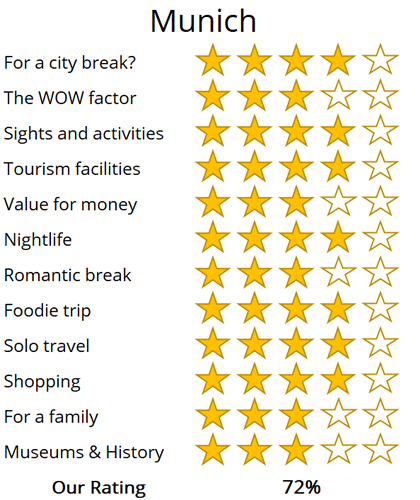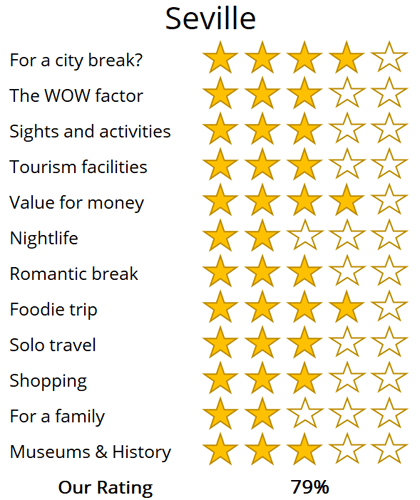WhereToGoForMyHoliday.com
The best destination comparison site!
WhereToGoForMyHoliday.com
The best destination comparison site!
Munich or Seville, which is better for your holiday in 2024?
Seville and Munich both offer unique and enticing experiences, but which one should you choose for your city break or holiday?
We recognise the difficulty in making this decision. While there is abundant information available on both destinations, clear guidance on which city better aligns with your travel preferences is often hard to find.
This article aims to provide an impartial comparison of Seville and Munich, and hopefully help you to choose the best city to visit.
The article is structured into several sections, each of which can be directly accessed through the following links:
• Introduction to the cities
• Scores and ratings
• Which one should I, friends, or family visit?
• When to visit and weather
• Who is the city suited for?
• The perfect 48hours (with map)
• Tourism details (where to stay? airport details?)
Introduction to Munich and Seville
Seville as a destination reflects that of the city’s famous dance, the flamenco; it is hot, passionate and instantly captivating. Seville boasts exceptional tourist attractions , and it’s rich cultural heritage will leave you longing for more.
Modern Seville is the interplay of its turbulent past, blending together Moorish roots and Christian influence in a city which wants to enjoy and embrace the present. Seville’s heritage is proudly displayed throughout the city, from the magnificent Alcázar palace, to the towering cathedral, mouth-watering tapas restaurants and impromptu flamenco dances.
Strangely, Seville typically lacks the appeal to the younger generation of tourists, but chance a trip and fall in love with the flare of southern Spain.
Beer-mad and shrouded by the mountains, Munich is the boisterous capital of Bavaria. It's in the deep southern reaches of the country, where lederhosen are the threads of choice and white sausage is served at breakfast. Proudly unique, romantic, and steeped in art and culture, you won't find anywhere else like this in Germany.
Of course, it's the legendary Oktoberfest that puts Munich on the map. One of the world's biggest festivals, it draws millions to the city in late September (yes, Oktoberfest is confusingly held in September) to glug huge beers and eat endless wurst. Trips at any other time of the year are sure to be a little more refined. They can involve long walks under Baroque churches, picnics in the English Garden park, and even daytrips to the stunning Bavarian Alps.

The Marienplatz and the historic centre of Munich, with the Frauenkirche Cathedral, and Neues Rathaus

The Torre del Oro once guarded the Guadalquivir river and Seville
High-level summary for Munich and Seville
Summary
Where would I journey for a personal escape? Munich
Where would I send my parents for a memorable visit?
Seville
Where's the ideal destination for my adventurous 19-year-old cousin?
Munich
Where should my food-obsessed friend indulge their culinary passions?
Seville
Note: The above comparisons are weather-independent and are based on travel during the most opportune times of the year. Details about the ideal travel seasons are elaborated upon later in this article.
In the sections that follow, you'll find a comprehensive comparison between these two fascinating cities. This includes recommendations on the duration of stay, the best times to visit, and tailored 48-hour itineraries for each city.
The final segment delves into practicalities for your travels, such as the best airport to fly into, the optimal districts for your accommodation, and insider tips, for when you come to explore the city.
We hope that you find all of this information useful, in planning your next exciting trip!
Destination details
How long to spend each city?
Take a couple of days minimum to get a feel for the alternative vibes of Munich. You'll need at least a morning or two to check off the grand churches and plazas of the downtown. Afternoons are often lost to a haze of currywurst and spätzle. The evenings will disappear to clinking tankards and too much Bavarian beer.
If you're planning on joining the Oktoberfest party, then the normal amount of time to spend in the Munich event is two days. Some people will stick around longer but remember that accommodation can cost a bomb during festival dates and you'll need to book well in advance.
The closeness of the Alps and the wide variety of off-the-beaten-path neighborhoods in Munich mean that it's also possible to stay here for much longer than just a weekend or a couple of days. You could do weeks of hiking in the spring and summer months. Alternatively, you could do a full ski holiday in nearby Garmisch-Partenkirchen (Germany's biggest resort) during the winter.
Seville calls for a more unhurried exploration to truly soak in its relaxed pace and tapas culture. Two days in Seville allow for a comprehensive sightseeing experience, though a single, brisk day could cover the essentials.
Be mindful of the extreme summer heat, necessitating an earlier start to your day and a slower pace.
For those looking to venture beyond, day trips to historic Cordoba, the coastal city of Cadiz, or the dramatic Pueblos Blancos are worthwhile, though the latter may require a rental car or guided tour due to limited public transport options.
Insight: While Granada is a captivating destination, it is best experienced as part of a longer itinerary, perhaps alongside Seville and Málaga, for a fulfilling week-long holiday.

Excessive amounts of beer, lederhosen, singing and crazy fairground rides… it can only be Oktoberfest

The Gothic Catedral de Sevilla
Munich is one of those cities that has something going for it no matter the time of the year. Lots of people like the height of the summer, for the regular sun and temperatures that often spike above 30 degrees in the middle of the day. That's certainly perfect for wandering the town and enjoying the big lawns and paths of English Garden.
The autumn is best known for Oktoberfest. The shindig and the beer drinking begin in mid-September, lasting until the first couple of days in October. It's usually still warm for the party, but the days get shorter and jumpers will be needed as you get closer to November.
There's often snow in Munich from December onwards. This is the time of year to come if you have your sights set on the ski fields of the German Alps. The slopes of Garmisch-Partenkirchen typically open for business before Christmas, which is also when the enchanting markets start selling gingerbread and sausages on Munich's medieval squares.
Spring is also lovely. May is among the best months of all to travel. The summer crowds haven't arrived yet, the snows have melted, and thermometers can read a pleasant 20 degrees during the day.
The best time of year to visit Seville is during the two festival periods of Semana Santa (held in the week before Easter) and the Feria de Abril (starting two weeks after Easter).
For a regular trip, late autumn and early spring are the best seasons, as during the long summer (June-September) the city is oppressively hot. Winter provides good value and fewer tourists but there is always the potential of rain.
Seville is a pleasure to visit, so long as you can either handle (or avoid) the extreme heat. This is a city for a slower paced trip, to enjoy time in the open-air cafes and to embrace the culture of Andalusia. This makes the city ideal for a break from a stressful lifestyle or hectic work schedule back at home.
The ambience typically appeals to a slightly older visitor, but to assume Seville is a mature destination would be completely wrong. There are exciting tourist attractions, a colourful nightlife and a social atmosphere. One of the appeals of Seville is that it is not a common city break and few of your friends will have been there.
Munich is unique in that it manages to fuse together the great outdoors, rich European culture, and an enticing foodie scene. That's all thanks to its place as the historic capital of Bavaria, which brings a long tradition of cooking, beer making, castle building – the list goes on.
The upshot? There are all sorts of travellers who are catered to, no matter if you come in search of pretzel eating or high-altitude trekking.
One thing you won't find in this city is the sea. The nearest saltwater is a hefty drive over the Alps in Italy or Croatia. So, don't come if you're pining to top up the tan and swim in the Med.

The Englischer Garten (English Garden) is the spawning park in the centre of the Munich

The Plaza de España is always a highlight of Seville
48hours in Munich
Sample Munich's famous food, beer, and regal inner city on this two-day itinerary that's packed with amazing palaces and parks. If you're hanging around for longer, then you should also have time to make a beeline for the Alps or explore those off-the-beaten-track neighborhoods, but that will have to wait…
Day 1: Your travels begin on the grand Odeonsplatz. A prime example of the city's 19th-century rebuilding, it hosts some of the most magnificent sights in the region. There's the huge, 130-room Munich Residenz, the onetime home of the Bavarian kings and queens. There's the Theatine Church from the 1600s, sporting its dual Baroque towers.
You only have 48 hours, but the palaces can be visited if you have extra time. Instead, move on through the heart of the city on Briennerstraße to the vast plaza of Königsplatz. This is a photo op extraordinaire, with handsome Neo-Classical monuments like the strange Propyläen. The area around that is the artistic quarter (the Kunstareal), where there are endless museums and galleries to go into if you need to warm up or escape the rain.
Next is the beautiful Frauenkirche. This is a symbol of Munich as a whole; a great church topped by bulbous domes on the central Frauenplatz. It will take around 20 minutes to walk over there, but you'll enjoy moving into the Altstadt area as you go. You should plan to spend the evening within, hopping between sights like the iconic Hofbräuhaus (the best known beer hall in the city) and the ancient Peterskirche (the oldest church in Munich).

The Schloss Nymphenburg and its beautiful grounds
Day 2: No visit to the grand royal capital of Bavaria could possibly be complete without at least a glimpse of the Schloss Nymphenburg. It's hardly central, but private tours can whisk you there and back in a single morning, going through the manicured gardens, the court rooms, and the curious Marstallmuseum with its gold-leafed carriages from the 19th century.
When you return back to the middle of Munich head straight for the English Garden. This is one of Germany's favourite parks. You could start by strolling up the Eisbach to see the surfers riding the river wave. Then explore the pretty Hofgarten, where babbling fountains and bandstands once provided a retreat for Bavarian royals. Alternatively, go straight to the Chinese Tower Beer Garden, to glug traditional German hops brews and taste bratwurst and pretzels until sundown.

The Olympiapark complex, constructed fro the 1972 Olympics
Below is an interactive map for 48 hours in Seville; day 1 is highlighted in green and day 2 in yellow, with optional sights in grey.
Start the day in the impressive Catedral de Sevilla, and climb to the top of La Giralda bell tower for a wonderful viewpoint. Surrounding the cathedral is the atmospheric Santa Cruz district, with its traditional houses and narrow cobblestone streets, which follow the old medieval layout of the city.
For the afternoon, visit the grand Plaza de España and the adjoining Parque de Maria Luisa. Towards the end of the day join a cruise along the Guadalquivir River. For dinner, head to the Triana district for an authentic Tapas meal. This district is also where flamenco dancing originated, and one of the bars may well have some impromptu dancing happening during the evening.

The gardens of the Real Alcázar palace
For the second day, start by visiting the Real Alcázar palace, the finest example of Mudéjar architecture which fuses Arabic and Christian designs. For the afternoon, head north of the historic centre and explore the popular shopping streets of Calle Sierpes. End the afternoon at the Setas De Sevilla, a massive wooden structure and great viewpoint.
In the evening, watch a flamenco performance at the La Carbonería.

The Setas De Sevilla is the world’s largest wooden structure, but few know what it actually is or the point of it……
Seville airport (SVQ) is 10km northeast from the city centre, and is connected by a regular bus service (35min €4.00). Many of the low-cost airlines focus on the coastal cities of southern Spain instead of Seville, which means the cost of flights can be surprisingly high - plus there are fewer departures. This means that demand for flights can be very high in summer (when the city is best avoided).
This high level of tourism also means that hotels tend to be more expensive than much of Spain, and it’s likely you will spend much more than you anticipated! If you are lucky enough to visit during the two festivals, book your accommodation well in advance. Seville is compact and very easy to explore on foot.

The Maestranza bullring; bullfighting is an important tradition in Seville
Munich International Airport is the second busiest hub in all of Germany. It's a major arrival point, with links coming in on premium and low-cost fliers from right around the globe. Getting to the city from the terminals is easy thanks to the direct S-Bahn line that runs straight to the train station. The trip costs just over €11 and takes around 40 minutes in total.
Long-distance overnight trains and local German trains alike will arrive at Munich Central Station. It's right in the heart of the city, within walking distance of the Altstadt and the Odeonsplatz. If you'd prefer not to walk to the door of your hotel, however, you can enter the S-Bahn or U-Bahn networks from there. Those, along with the comprehensive bus routes and tram lines, can get you virtually anywhere in the town. Basic one-way single tickets cost €2.80 per ride. Buy them at the blue vending machines located in the stations.
Munich is a safe, modern city. The locals are famed for their friendliness and welcoming attitude – a trait of Bavaria, they say. However, it's still important to be wary of scams and dangers, particularly during the Oktoberfest, when alcohol intake increases dramatically.
The best areas to stay in Munich are the Altstadt, the streets around English Garden, and the grand university and gallery area of Maxvorstadt. Cheaper hotels that are still within walking distance of the sights can be found south of the main train station around Bayerstraße.

The Odeonsplatz plaza and the distinctive yellow Theatine Church

oh we were stuck in the airport!

Copenhagen was a bit expensive...

All we did was drink beer in Brussels...

Muncih was crazy

And we got so burnt!

Remeber that night in Rome

oh we were stuck in the airport

So much fun kayaking

Berlin and that group from Austria!

There was such a view from that church

And we got so burnt!

Munich was eventful, wasn't it!

Such a view from that cathedral in Florence

Lisbon was such so much fun

Last summer was so much fun .... x

Remeber that night in Rome

Lisbon was such so much fun

Such a view from that cathedral in Florence

Munich was eventful, wasn't it!

And we got so burnt!

Remeber that night in Rome

All we did was drink beer in Brussels...

Berlin and that group from Austria!

Can't wait to go back to Dubrovnik

Remember that boat ride in Prague

Copenhagen was a bit expensive...








